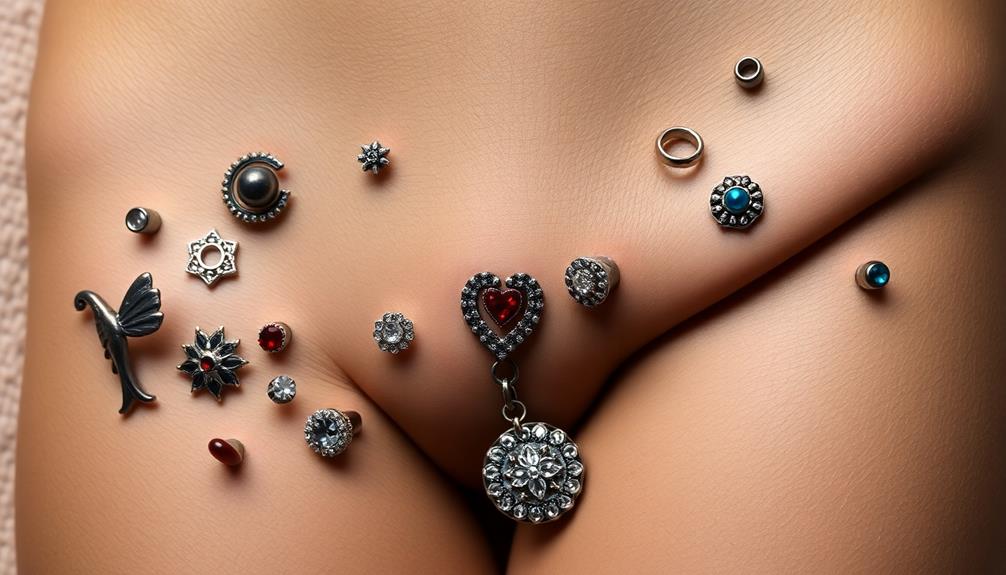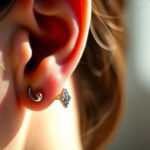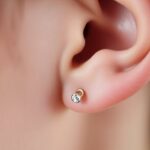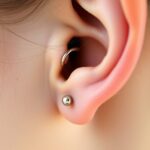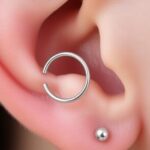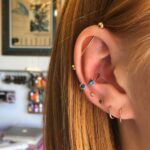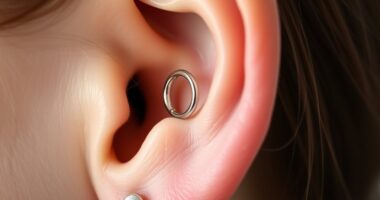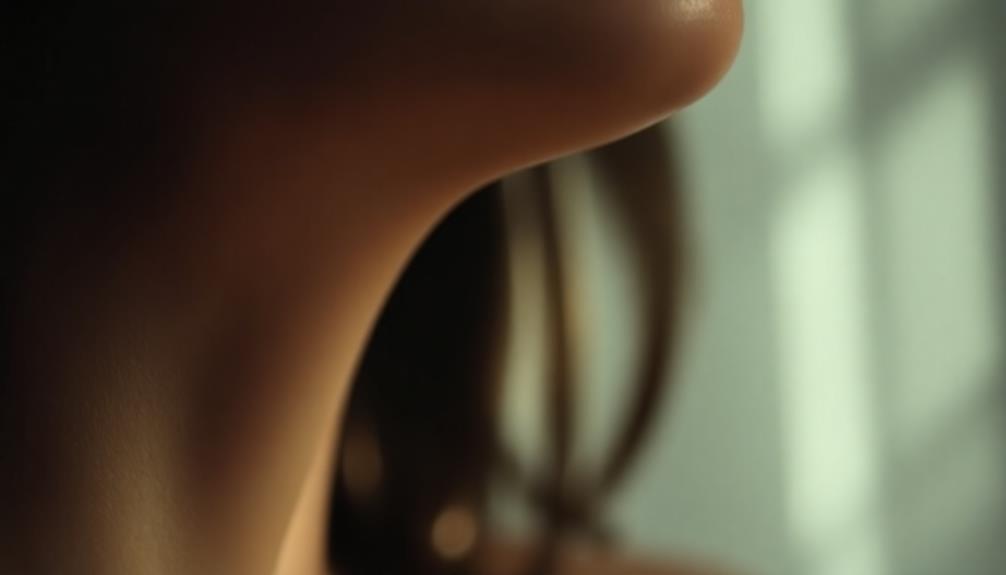When considering conch piercings, you'll find two main options: inner and outer. The inner conch sits closer to the ear canal and takes longer to heal, usually around 6 to 12 months. It may be slightly more painful, rated about 6 out of 10. In contrast, the outer conch heals faster, typically in 3 to 6 months, and offers more diverse jewelry styles. Both require good aftercare to minimize risks. Think about your pain tolerance, healing time preference, and jewelry choices before deciding. Explore further to pinpoint what's best for your unique style.
Key Takeaways
- Inner conch piercings take longer to heal (6 to 12 months) compared to outer conch piercings (3 to 6 months).
- Pain levels for both inner and outer conch piercings are similar, generally rated around 6 to 7 out of 10.
- Inner conch piercings typically use labret studs for a discreet look, while outer conch piercings allow for larger hoops and decorative styles.
- Proper aftercare is crucial to minimize complications and ensure successful healing for both types of conch piercings.
- The choice between inner and outer conch piercings depends on personal preference for visibility, healing time, and jewelry style.
Overview of Conch Piercings

Conch piercings, named after their resemblance to a conch shell, are a popular choice for those looking to enhance their ear jewelry. Located in the middle cartilage of your ear, these piercings can be categorized into two types: inner conch and outer conch. The inner conch is situated closer to your ear canal, while the outer conch rests on the flat area of your outer ear.
When considering a conch piercing, it's important to note the healing time. Generally, it can take anywhere from 3 to 9 months for your piercing to heal, depending on your skin type and aftercare. The inner conch usually requires more time to heal compared to the outer conch, which tends to be less sensitive and often adorned with larger hoops.
Pain levels for conch piercings range from 6 to 7 out of 10, primarily due to the thickness of the cartilage.
Both inner and outer conch piercings offer fantastic opportunities for customization, allowing you to mix and match jewelry styles for a unique, stacked look.
Inner Conch Piercing Details

Exploring the inner conch piercing reveals its unique placement within the ear's cartilage, right next to the ear canal. This piercing typically features a labret stud, which provides a subtle look while accommodating potential swelling during the healing process.
Expect the healing time for your inner conch piercing to range from 3 to 9 months. Individual experiences may vary, so following proper aftercare is essential for a smooth healing journey. While the inner conch piercing can be more painful than lobe piercings, rated at about 6/10, the aesthetic appeal often outweighs the discomfort.
Here's a quick overview of the inner conch piercing:
| Aspect | Details | Notes |
|---|---|---|
| Placement | Central area of ear's cartilage | Adjacent to the ear canal |
| Healing Time | 3 to 9 months | Varies by skin type and care |
| Jewelry Options | Labret stud or decorative pieces | Allows for personal expression |
Choosing the right piercing jewelry can enhance the beauty of your inner conch while also ensuring comfort during healing.
Outer Conch Piercing Insights

When considering an outer conch piercing, you'll find a wide range of jewelry options, from larger hoops to decorative studs that really stand out.
The healing time is generally quicker than inner conch piercings, usually taking about 3 to 9 months.
Keep in mind that pain levels can vary, but many rate it around a 6 out of 10, similar to inner piercings.
Jewelry Options Available
Outer conch piercings offer a variety of jewelry options that can elevate your style. With the right pieces, you can express your individuality while ensuring comfort. The typical gauge size for these piercings is 16G (1.2mm), which strikes a balance between aesthetic appeal and wearability.
When it comes to jewelry types, you have several choices, including larger hoops that provide dynamic styling. Here's a quick overview of popular options:
| Jewelry Type | Description | Material Options |
|---|---|---|
| Seamless Hoops | Simple, clean design without visible seams | Implant-grade titanium, surgical steel |
| Segment Hoops | Features removable segments for easy wear | Implant-grade titanium, surgical steel |
| Clicker Hoops | Easy to open and close for convenience | Implant-grade titanium, surgical steel |
| Gemstone Adorned | Decorated with gems for added flair | Hypoallergenic materials |
| Unique Designs | Custom shapes and styles for personal touch | Various hypoallergenic metals |
Choosing the right jewelry can enhance your outer conch piercings while reflecting your personal style. Make sure to wait until your piercing is fully healed before switching to more elaborate options!
Healing Time Expectations
Understanding healing time expectations for your conch piercing is essential for a smooth recovery. For an outer conch piercing, the healing time typically ranges from 3 to 6 months.
However, individual factors like skin type and aftercare can influence this timeline. Compared to inner conch piercings, which may take up to a year to heal, outer conch piercings tend to recover faster due to their placement on the outer cartilage.
To guarantee you navigate the healing process effectively, consider these key points:
- Follow Aftercare Instructions: Regularly clean the area and avoid irritants to minimize healing time and reduce the risk of complications.
- Monitor Symptoms: Some swelling and tenderness are normal. Keep an eye on these symptoms to gauge your healing progress.
- Leave Jewelry in Place: Don't change the jewelry too soon. The initial jewelry should stay in place for at least 3 to 6 months to guarantee complete healing.
Pain Level Assessment
Getting an outer conch piercing can bring a mix of excitement and apprehension, especially regarding the pain level. Generally, people rate the pain from this piercing around 6 to 7 out of 10, largely due to the thicker cartilage in that area. Many describe the sensation as a sharp pinch, with the pain subsiding quickly after the initial puncture.
However, remember that pain experiences can vary greatly based on individual pain tolerances and anxiety levels. What feels intense to one person might be barely noticeable to another.
While outer conch piercings tend to be more painful than lobe piercings, they're usually less painful than other cartilage piercings, like the tragus.
To help ease discomfort during the healing process, follow proper aftercare. Avoid touching or twisting the jewelry, as this can lead to unnecessary irritation.
Pain Levels and Sensations

Pain during conch piercings can be a significant factor for those contemplating this body modification. On the pain scale, conch piercings typically rate between 6 to 7 out of 10. The intensity can vary based on your individual pain tolerance and the specific area being pierced.
Here are three key points to reflect on:
- Inner Conch vs. Outer Conch: If you're opting for an inner conch piercing, expect sharper and more intense pain due to the thicker cartilage compared to the outer conch, which may feel slightly less painful.
- Initial Sensation: Many people report a sharp pinch during the piercing, followed by a dull ache. However, some experience minimal discomfort, highlighting the variability in pain perception.
- Post-Piercing Care: Healing discomfort can arise after the procedure, especially if the jewelry is moved or disturbed. Proper aftercare is essential to minimize pain and promote healing.
Understanding these factors can help you prepare for the experience and make informed decisions regarding your conch piercing journey.
Healing Time Comparison

When it comes to healing times for conch piercings, you'll notice a distinct difference between the inner and outer variations. The inner conch typically has a longer healing time, ranging from 6 to 12 months. This extended period is often due to its proximity to the ear canal and the thicker cartilage involved. On the other hand, outer conch piercings generally heal faster, averaging 3 to 9 months. This quicker recovery makes them a popular choice for those who prefer less downtime.
Healing times can vary considerably based on individual factors like skin type, body chemistry, and aftercare practices. It's important to maintain diligent aftercare for both types of piercings to prevent complications that could lead to even longer healing times. Additionally, monitoring for signs of infection is vital, as untreated infections can prolong the healing process.
Here's a quick comparison of the healing times:
| Type of Conch | Average Healing Time | Notes |
|---|---|---|
| Inner Conch | 6 to 12 months | Thicker cartilage |
| Outer Conch | 3 to 9 months | Generally faster recovery |
| Individual Variation | Varies | Depends on personal factors |
| Aftercare Importance | Critical | Prevents complications |
Aftercare Essentials

After getting a conch piercing, it's vital to stick to proper cleaning techniques to keep the area hygienic.
You'll want to avoid any movement of the jewelry and monitor for signs of infection closely.
Following these aftercare essentials will help guarantee a smooth healing process.
Cleaning Techniques
To guarantee your conch piercing heals properly, cleaning it twice daily with a saline solution or saline spray is vital. This simple cleaning technique helps prevent infection and promotes ideal healing.
Avoid using soap, alcohol, or hydrogen peroxide directly on the piercing, as these can irritate the tissue and delay your healing process.
Here are some key cleaning steps to follow:
- Use Clean Hands or Sterile Tools: Always wash your hands thoroughly or use sterile tools to minimize the risk of introducing bacteria during the cleaning process.
- Gently Wipe Around the Jewelry: When cleaning, carefully wipe around the jewelry without twisting or moving it. This prevents trauma to the piercing, which is important during the healing period.
- Monitor for Signs of Infection: Keep an eye on your piercing for increased redness, swelling, or discharge. If you notice any concerning symptoms, consult a professional immediately.
Jewelry Movement Restrictions
Jewelry movement restrictions are essential for ensuring your conch piercing heals properly. Unnecessary movement of the jewelry can lead to irritation, prolonging the healing stage and increasing the risk of complications.
To support your healing, it's important to keep the jewelry still and avoid any pressure from hats, tight headphones, or accessories. These items can cause trauma to the piercing, making it harder for your body to heal.
During this period, keep your hair tied back and away from the piercing to prevent tangling or accidental pulling of the jewelry. Regularly monitor the site for signs of infection, such as redness or swelling.
Infection Monitoring Tips
Keeping a close eye on your conch piercing is essential for preventing infections during the healing process. Regular inspections can help you catch any potential issues early. Here are some infection monitoring tips to keep in mind:
- Inspect Daily: Check your piercing for increased redness, swelling, or discharge, especially during the first few months. These signs could indicate an infection that needs attention.
- Clean the Area: Make sure to clean the piercing site at least twice daily using a saline solution or antiseptic spray. This practice minimizes the risk of infection and aids in healing.
- Avoid Irritants: Refrain from touching or twisting the jewelry, as this can introduce bacteria. Also, limit exposure to pools, hot tubs, and other bodies of water until the piercing is fully healed.
If you notice persistent symptoms like fever or worsening pain, consult a professional piercer or healthcare provider immediately.
Early detection and proper care are key to ensuring your healing process goes smoothly and safely.
Jewelry Options for Conch Piercings

When it comes to selecting the right jewelry for your conch piercings, you'll find a range of options that cater to both inner and outer piercings. For inner conch piercings, labret studs are the most common choice, while outer conch piercings often feature larger hoops or seamless rings for a bolder look.
Jewelry options typically range in gauge sizes from 14G to 16G, with your piercer determining the best size based on your individual anatomy. It's vital to choose the right gauge to guarantee a comfortable fit and promote healing.
When considering material options, go for implant-grade titanium, surgical steel, or hypoallergenic gold. These materials minimize the risk of allergic reactions during the healing process, which is significant for your comfort and safety.
After the initial healing period, usually around six months, you can explore various styles and designs, including decorative gemstones and unique shapes that reflect your personal style.
Just remember to consult with a professional piercer before making any jewelry changes to guarantee safe and proper modifications.
Cost Considerations

Considering a conch piercing involves not just the procedure itself but also the costs associated with it. The average cost of a conch piercing ranges from $30 to $90, influenced by the piercer's expertise and location. When you factor in the price of quality jewelry, you might find the total expenses rising.
Here are some key cost considerations to keep in mind:
- Initial Piercing Costs: Expect to pay between $30 and $90 for the piercing itself, depending on your chosen artist and their experience.
- Jewelry Expenses: Quality jewelry can add another $50 to $100. Opting for implant-grade titanium or surgical steel is essential to avoid allergic reactions and guarantee a smooth healing process.
- Aftercare Products: Don't forget to budget for aftercare supplies, as maintaining hygiene is important during the healing process. These products can add to your overall costs.
Prioritizing the piercer's experience and the quality of jewelry over the lowest price can save you from complications and guarantee a successful healing experience.
Investing wisely here will pay off in the long run.
Potential Risks and Complications

Steering through the world of conch piercings comes with certain potential risks and complications that every individual should be aware of. Neglecting proper aftercare can lead to infections and inflammation during the healing process, which can take anywhere from 3 to 9 months. Avoid using earbuds until your piercing is fully healed, as they increase the risk of irritation and infection.
It's also essential to recognize signs of complications early on. If you notice excessive redness, swelling, or discharge, consult a professional piercer or healthcare provider immediately.
Here's a quick overview of potential complications:
| Complication | Description |
|---|---|
| Infection | Caused by improper aftercare or irritants. |
| Keloid Formation | Excessive scar tissue growth, especially for sensitive skin. |
| Prolonged Healing | Increased discomfort and pain, rated 6-7 out of 10. |
| Signs of Complications | Redness, swelling, or discharge indicate issues. |
Choosing the Right Piercing

After understanding the potential risks and complications associated with conch piercings, it's time to focus on how to select the right one for you.
The choice between an inner conch and an outer conch piercing hinges on several key factors:
- Location: The inner conch is closer to the ear canal and typically requires a labret or cartilage stud, while the outer conch is on the flatter part of your ear, allowing for diverse jewelry options like hoops.
- Healing Time: If you prefer a quicker healing process, the outer conch may be your best bet, as it usually heals faster than the inner conch, which can take 6 to 9 months.
- Aesthetic Preference: Consider how visible you want your piercing to be. The inner conch offers a more subtle look, while the outer conch makes a bolder statement, showcasing your unique style.
Ultimately, choosing the right piercing involves balancing pain tolerance, healing time, and your personal style.
Think carefully about these factors to guarantee you make a decision that aligns with your preferences and lifestyle.
Frequently Asked Questions
What Is the Difference Between Inner and Outer Conch Piercings?
When you compare inner and outer conch piercings, you'll notice they differ in placement, healing times, jewelry styles, and aftercare needs. The inner conch is deeper, while the outer offers more design flexibility.
How Bad Does an Outer Conch Piercing Hurt?
About 30% of people rate outer conch piercings as a 7 on the pain scale. You'll feel a sharp pinch followed by pressure, and discomfort may linger for days, but proper care can help.
Can You Put a Hoop in an Inner Conch Piercing?
Yes, you can put a hoop in an inner conch piercing, but it's best to wait until it's fully healed. Initially, stick with a stud to minimize movement and irritation during the healing process.
How Do You Know if You Have the Anatomy for a Conch Piercing?
You might wonder if conch piercings fit your anatomy. Check your ear's cartilage size and shape. A professional piercer can assess its suitability during a consultation, ensuring enough space for your desired jewelry.
Conclusion
In the grand symphony of body art, conch piercings play a fascinating melody, whether you choose the inner or outer route. As you navigate your decision, remember that each option offers its own unique harmony of style and sensation. Embrace the journey, weigh the risks, and let your personal taste guide you. Ultimately, this choice is your chance to add a striking note to your aesthetic composition, creating a beautiful narrative that's distinctly yours.
Hi, my name is Danielle, and I’m an author for piercings-body.com. I have a passion for writing and love to share my knowledge on all things body piercing-related. I’m also a huge advocate for safe body modification practices and believe everyone should be able to make informed decisions about their bodies. When I’m not writing or blogging, I enjoy spending time with my family and friends, practicing yoga, and exploring new places.


